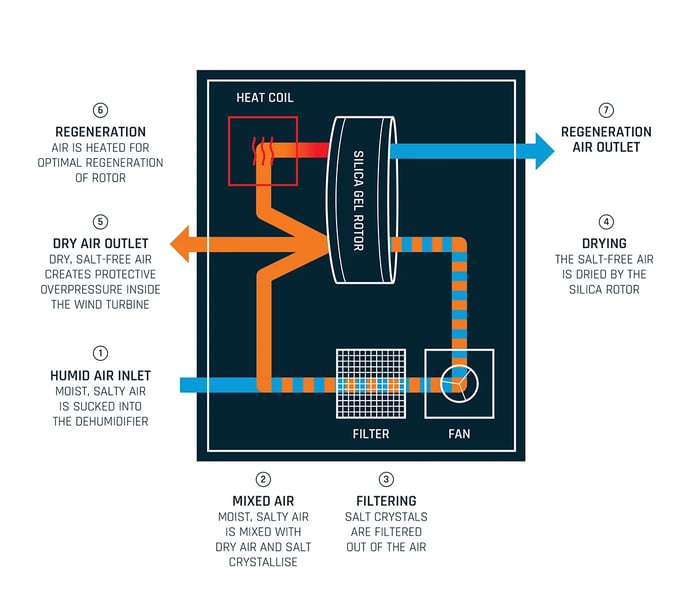It depends on the wind turbine design, but a dry-air strategy is the most viable and effect way to dry the inside of a wind turbine tower or nacelle.
In general, you have two options, depending on the design of the tower and nacelle. Suppose you have a closed design, with limited air infiltration in your structure. In that case, we can create a slight overpressure in the whole structure that prevents air from entering whilst we remove the salt and humidity from the air inside the structure.
- The moist or humid air inside the structure is pulled into the dehumidifier.
- Moist, salty air is mixed with dry air salt-free air causing the salt to crystalize.
- Salt crystals are filtered out of the air and collects in a removable tray.
- Moist, but salt-free air is dried by the silica rotor.
- Dry air is divided into three different flows. A) Dry salt-free air mix with incoming moist air to remove salt from the air B) Dry salt-free air pushed into the structure to protect the electrical equipment and other critical components C) Dry salt-free air for the regeneration (moisture removal) of the silica rotor
- Regeneration airflow is heated to optimal temperature for moisture removal on the silica rotor
- Moist air is then pushed out of the dehumidifier and out of the structure

When overpressure pulls the air from the outside, the air entering is mixed with dry air, leading the salt to crystalise. Here, the salt crystals are pulled onto a tray and the dehumidifier sends salt-free air into the offshore turbine. In this solution, you have protected the entire structure against mould, corrosion, creating an office-like environment for the electronics inside.
Find the right dry-air strategies for a fleet of offshore wind turbines
The benefits of dry air:
-
Avoiding mould and corrosion
-
Avoiding electrical faults in your turbines
-
Safeguarding durability and performance of sensitive equipment
-
Creating a safer working environment
-
Faster, glitch-free turbine commissioning
-
Lower costs for materials, coating and components

